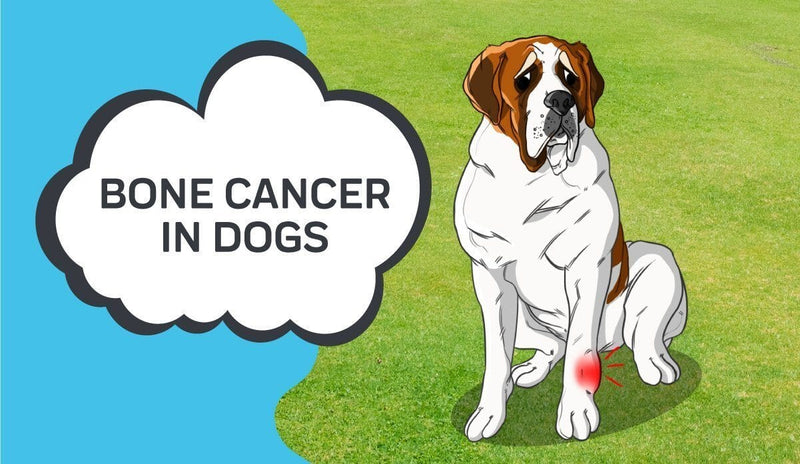- The Three Kinds of Mast Cell Dog Tumors
- What Are the Symptoms of Mast Cell Tumors?
- Risk Factors of Mast Cell Tumors
- How Are Mast Cell Tumors Diagnosed?
- Treatment Options for Dogs: How To Treat Canine Mast Cell Tumors
Often abbreviated as MCTs, mast cell tumors are one of the more commonly found tumors in dogs. In fact, out of all cases of canine cancer, 20% of dogs with cancer are diagnosed with mast cell tumors. The main reason why mast cell tumors are so frequently found in dogs is that these tumors can grow from just about anywhere on your dog's body.
Not all mast cell tumors in dogs have the same appearance either so they not only grow with ease but they can take on just about any form as well. Adding fuel to the fire, tumors that stem from the rapid growth of mast cells are also incredibly aggressive making them difficult to keep under control. The cancerous cells metastasize very rapidly, so keeping these tumors under control is imperative.
Finding the location of the tumor is one of the first steps. Bone marrow is a common location for MCT in dogs, but bone marrow isn’t the sole site of origin. Other locations of origin include the liver, spleen, and gastrointestinal tract of our canine companions.
The Three Kinds of Mast Cell Dog Tumors
Medical professionals use a grading system to differentiate between mast cell tumors. The grading system places mast cell tumors into one of three categories…
- Grade I
- Grade II
- Grade III
Grade I
Grade I refers to benign mast cell tumors. They are the least concerning and the easiest to control of the three grades, though they absolutely require treatment sooner than later.
Grade II
Grade II is the category of locally aggressive mast cell grade tumors. They stay local for awhile but this doesn't mean they don't have a high probability of spreading elsewhere. Veterinarians will reference the mitotic index of these tumors to better understand how quickly the cancerous cells will begin multiplying and dividing.
Grade III Mast Cell Dog Tumor
Grade III mast cell tumors have the highest likelihood of spreading throughout the body. These grade tumors metastasize rapidly. The grade III tumors require immediate intervention because you're working with a shorter time frame. Due to its security, a grade III tumor will often require the introduction of toceranib phosphate as part of the treatment plan.
Even if your dog does not have a mast cell tumor, it's still beneficial to educate yourself about mast cells and lumps because they are such a common form of cancer in dogs. How about we explore the various symptoms of dogs with mast cell tumors so that pet owners can familiarize themselves with the signs of canine mast cell tumor.
Then, we'll advise you on the various tools used for diagnosing mast cell tumors, followed by an explanation of treatment options for canine mast cell cancer. Let’s get started!
What Are the Symptoms of Mast Cell Tumors?

Mast cells are the most common type of tumor in dogs. It affects one out of every three pets, and there's no way to tell if your pet will develop a mast cell tumor until after it has started growing. The signs that you'll notice depend on how high grade the cancer is. They can include redness or lumps around any part of their body as well as swelling at various sites like their neck area or back legs. If these symptoms occur suddenly and persist for more than two weeks with no other obvious explanation then get your pup examined by a veterinarian right away!
The warning signs of mast cell tumors in dogs are very eerily similar to the symptoms of cancer in general. Theoretically, it sounds like it would be easier to know that your dog has a mast cell tumor if the side effects of canine mast cell tumors were more unique or distinguished. However, it’s okay that you don’t know the cancer is a mast cell tumor right away.
The main focus is to seek medical attention for your dog after seeing signs of irregular behavior and recognizing that something is wrong. Don’t worry about trying to figure out what type of cancer your dog has in the moment. Instead, your goal should just be to notice something is wrong and take your dog to the vet for an evaluation.
Once you have a feeling that your dog is not behaving like normal, schedule an appointment with your dog’s veterinarian. The veterinarian will then be able to evaluate the situation and narrow it down to a specific type of cancer. None of these symptoms are necessarily specific to mast cell tumors, but instead, they are indicative of cancerous cells in general. Always be on the lookout for signs of cancer in dogs so that you can seek out help for your pet sooner than later.
Some examples of cancer in dogs, including mast cell tumors, are…
- Raised bump along the skin
- Lymph nodes that are swollen
- Gastrointestinal pain and discomfort
- Sudden unexplained weight gain
- Loss of appetite or nausea
- Vomiting after eating
- Bowel movement issues like diarrhea
- Weakness and limp muscles
- A cough that won't go away
Swollen or enlarged lymph nodes are a clear giveaway that cancer is present in your dog’s body. This is true for two main reasons. The first explanation for why lymph nodes swell in the presence of cancer is that the cancerous cells start invading and spread to lymph nodes.
Evidence of spread occurs when mast cells often latch onto lymph nodes and spread throughout the body, which is known as lymph node metastasis. In other cases, the lymph nodes try to combat the cancerous cells, which causes them to swell in response to the cancer.
Risk Factors of Mast Cell Tumors
Researchers are still trying to figure out what exactly causes canine MCTs. There is an association between MCTs in dogs and the receptor tyrosine kinase, but there is not enough of a connection between receptor tyrosine kinases and MCTs to say RTK causes these tumors in dogs.
All that is known for certain is that some dogs are predisposed to developing mast cell tumors later on in life. Purebred dogs rarely develop mast cell tumors, as this type of canine cancer is more prevalent in mixed breeds.
Certain dog breeds have a higher likelihood of developing mast cell tumors, including but not limited to...
- Beagles
- Boxers
- Boston Terriers
- Bulldogs
- Cocker Spaniels
- Pitbulls
- Retrievers
- Rhodesian Ridgebacks
- Schnauzers
- Sharpeis
- Weimaraners
How Are Mast Cell Tumors Diagnosed?

The most common way of diagnosing a canine mast cell tumor is by conducting a fine needle surgical aspiration. The medical professional will take a needle, gently poke through your dog's skin, and pull a small sample of the mast cell tumor out of your dog. The needle draws the sample of cancerous cells out and into a syringe, which they then take to the lab for clinical testing.
Placing the sample of cancerous cells onto a slide, the professionals will then view the cells under a microscopic lens to really understand what's going on in your dog's body. Fine needle aspirations are often enough to understand the situation, but sometimes, a more invasive approach is necessary. If the needle aspiration isn't enough, veterinarians will often opt for a biopsy as well.
Biopsies are surgical because larger samples are taken, and typically, dogs are placed under anesthesia during biopsies. Mast cell tumors are often complex enough to warrant a biopsy, so don't feel too worried if your dog's veterinarian orders one. It's not a sign of anything other than the fact that the findings of the needle aspiration were not conclusive.
To calm any worries you might feel after learning your dog might need a biopsy, keep in mind that mast cell tumors often take the shape of non-cancerous abnormalities, like allergic reactions or bug bites. Since mast cell tumors don't take on a shape that is unique to them, it's easy to mistake mast cell tumors for something else.
This is why the diagnostic testing options seem so intense, but it's only because the professionals want to ensure that they know what they are dealing with before attempting treatment of the situation. Last but not least, a prognostic panel might be ordered when diagnosing mast cell tumors.
Prognostic panels offer a more in-depth approach to your dog's circumstances. It's a deeper dive into the genetic composition of the concerning lump. Additionally, a prognostic panel can provide insight into the severity of the cancer, which allows medical professionals to form a more well rounded opinion of your dog’s mast cell tumor survival rate.
Treatment Options for Dogs: How To Treat Canine Mast Cell Tumors
There are two major ways that veterinarians go about treating mast cell tumors. It all starts with weighing your dog’s prognosis versus the treatment options and deciding if one form of treatment is enough, or if they should be used in combination.
Surgical Removal of Canine Mast Cell Tumors
An abdominal ultrasound will often precede surgical removal of tumors in dogs. Surgical removal is frequently the go-to treatment option with MCTs in dogs when the skin tumor is of a considerable size. Surgical removal is often paired with another treatment option because surgery alone cannot promise to eliminate all cancer cells in your dog’s body.
Radiation Therapy for Canine Mast Cell Tumors
Radiation therapy is a key component in the treatment plan of dogs with skin tumors. Radiation therapy can successfully eliminate skin tumors by targeting the cancer cells directly. Radiation therapy utilizes UV lights to kill existing cancer cells and prevent new ones from growing. Although many pet owners do not like the idea of using radiation therapy on their dogs, it is definitely an option that is available and used by many.
Furthermore, the treatment of canine mast cell tumors with radiation therapy is a relatively new and exciting area in veterinary oncology. Radiation therapy can be used to treat both localized and metastatic disease. In recent years, there has been an increased focus on the use of novel therapies for the management of these aggressive neoplasms through radiation therapy.
Sources:
Mast Cell Tumors in DogsCanine Mast Cell Tumors
Tumors of the Skin in Dogs
Mast Cell Tumor (Mastocytoma) in Dogs
Mast Cell Tumors in Dogs
Cannabinoids in cancer treatment
Cannabis and Cannabinoids
Cannabinoids
Cannabidiol as potential anticancer drugThe Endocannabinoid System
Mast Cell Tumors in Dogs


















Thanks for saving my Lab. She started throwing up after eating, so I started to search around for lumps and found one. Off to the vet ASAP.